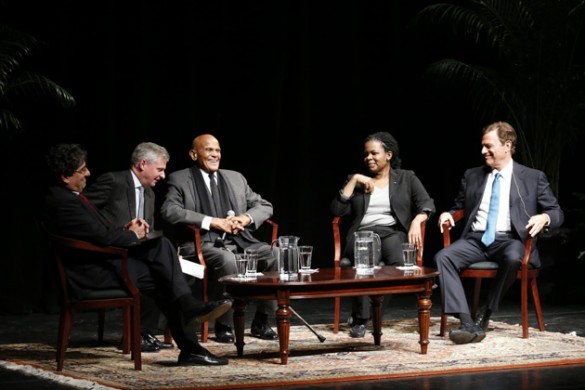
Harry Belafonte, an icon of American stage and screen with a lifelong commitment to social activism, recalled his experiences during the civil rights movement at a Chancellor’s Lecture Series event Jan. 13 in Langford Auditorium.
Vanderbilt Chancellor Nicholas S. Zeppos and award-winning historians Annette Gordon-Reed and Michael Beschloss joined Belafonte for a far-reaching conversation on the history, legality and politics surrounding the Voting Rights Act of 1965, which marks its 50th anniversary this year. Distinguished Visiting Professor Jon Meacham moderated the event.
Belafonte noted that the national mood following World War II was one of great optimism, but that mood did not translate for everyone—especially black Americans.
“Many black soldiers came back with a sense of the future, that they would be held accountable for democracy and the right to vote,” he said. “In fact, we came back to a highly heightened set of segregationist laws that became more punitive. It was in this period that I think the roots of the civil rights movement took hold. [rquote]We came back and saw what the world was to be, and we decided that we would not go back to business as usual.”[/rquote]
Belafonte said that several forces coalesced in the 1960s around the idea of using nonviolence as a tool for demonstration, which initially was a “tough sell” by Martin Luther King Jr. and other leaders to those in the black community.
“Many found the concept much too passive,” he said. “But as we began to be more engaged in the study of Gandhi and Thoreau … we began to see the enormous advantages in adopting nonviolence—initially as a tactic, and then as part of our deeper philosophy. And for that I am truly grateful.”
The historic Selma to Montgomery marches of 1965—three protest marches that were attempts to walk the 54-mile stretch of highway from Selma, Alabama, to the state capital in Montgomery despite threats of violence and actual violence by law enforcement—resulted in the passage of the Voting Rights Act of 1965, a landmark piece of federal legislation that prohibits racial discrimination in voting. But the legal groundwork for the Voting Rights Act and the Civil Rights Act of 1964 was being laid as early as the 1920s and ’30s, said Gordon-Reed, who serves as the Charles Warren Professor of American Legal History at Harvard Law School. She said law and social activism worked in concert to bring about change.
“Law reflects society and shapes society in America, because Americans are so legalistic,” she said. “But law and social action are a dialectic—they go hand in hand.”
Black legal scholars began assembling cases, including 1954’s Brown v. Board of Education, to chip away at segregationist laws and usher in the sweeping social legislation of the 1960s. “[lquote]But law always has its limitations, so direct action comes in and helps,” Gordon-Reed said. “Law legitimizes things, but they both have to work together.”[/lquote]
Growing negative sentiment over the Cold War also played a role.
“There was a battle going on about a way of life, a system of government,” she said. “I think there’s no question that the civil rights movement was helped along by the Soviet Union and China and these battles of ideology. How can we condemn the Soviet Gulag or Chairman Mao when we’re not treating our own citizens with equality?”
Beschloss, who has written two volumes on President Lyndon Johnson’s White House recordings, said that Johnson was committed to passing civil rights legislation from the moment he took office—despite the late president’s depiction in the current film Selma.
“The first night that Lyndon Johnson was president, the 22nd of November, 1963, he went back to Washington, D.C., after leaving the motorcade at the time of John Kennedy’s assassination,” Beschloss said. “As he lay in bed with a few of his aides in the room, he said, ‘In the next year or two as president, especially if I’m reelected, I want to get John Kennedy’s civil rights bill passed. I also want to get a voting rights bill passed.’ He said that the first night.”
By January 1965, Johnson was skeptical that a voting rights bill would happen that year. Beschloss said the actions and visibility of the demonstrators at Selma in March 1965 helped make the legislation a reality by August—just as photographs of young African American demonstrators being set upon by rabid-looking police dogs in Birmingham a few years earlier had swayed public opinion during Kennedy’s administration.
Belafonte said he thinks that America “was at one of its best moments at the time of the peace movement.”
“Soon after the death of Dr. King and the ending of the war in Vietnam, we blinked,” he said. “We went back in to what has become almost 50 years of suffering and wandering and losing our way.”
Belafonte has renewed hope in the youth of today. “I’ve chosen to invest almost all of my time and energy and resources now in the large number of young people around the country—from California to Boston to Maine to Texas—who are primarily in disenfranchised communities,” he said. “I’ve decided to use the autumn of my winter years to service this demographic. Because it’s in this group that I see enough naiveté, enough openness, to be able to take on today’s challenges.
“I think it’s important to recognize the young people involved in the Occupation Movement, the Arab Spring, at Ferguson—the awakening of youth globally. It’s an extension of what we were trying to achieve back in the days of Selma,” he said.